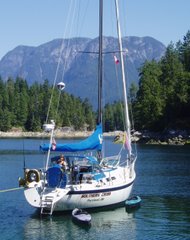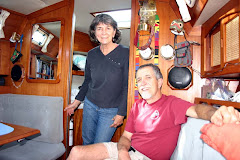Sunday, June 16, 2013
Passage to Niue
After 10 days at Mopelia, we were ready to get underway. My only regret is that conditions were not favorable for diving on the famous German shipwreck Seeadler, just outside the pass. I doubt I'll ever have that chance again.
We have had a lot of discussion regarding the route west from French Polynesia. As the route passes through the Cook Islands, it seemed only natural that we would visit at least one of them. I had always intended to visit Suwarrow, an uninhabited (except for two park wardens in the cruising season) atoll in the Northern Cooks. But the route from there would take us to the very rainy Samoas, in which I had very little interest, and it would be a potentially difficult passage from there south to Tonga. Friends who visited Suwarrow last year reported a lot of bad weather, and the guidebooks cautioned against staying in the anchorage in anything but settled weather. So we decided against Suwarrow. We also considered Rarotonga, in the southern Cooks, where our friends on Sorceress had gone a few weeks ago and enjoyed it. But you have to med moor in a very small crowded harbor, and our friends reported very rocky and rolly conditions, so we decided against that route. That left only Aitutaki, whose entrance channel is too shallow for our draft, and Palmerston, where you have to stay in the open sea on a mooring that is unsafe in a westerly.
Having ruled out these stops, we were faced with an 1150-mile passage to the Vavau island group in Tonga. This would be our second-longest passage on Southern Cross, and by far our longest double-handed passage. We set an intermediate waypoint at Niue, but we would only stop there if conditions were good.
Although the weather along the route was still not ideal, we decided to head out while conditions looked so good for the early part of the passage. And our first two days were very nice: light tradewinds and very moderate seas. We averaged nearly 6 knots for the first 48hours, sailing conservatively with a single reef the entire time.
Luckily it was at this time that I discovered that the pesky screw in the mast track was coming loose again. I had already tried Loctite, so my only option at this point was to climb the mast and remove the screw. Thank God it was only just above the first spreader. Even in light seas it was very hard to cling to the mast while aloft.
Conditions went lighter the 3rd day out, and our mileage dropped, even with a full main and a full 140% genoa. On day 4, we had to motor a few times as we moved into the influence of the low pressure system to our west. Winds backed to the NE and we saw our first squalls. On day 5, the winds continued backing to the SW, and we had to motor some more. The sky had the most dramatically varied clouds I had ever seen.
Toward the end of day 5 we spotted Palmerston Island, which we had set as an intermediate waypoint. It was just as well we had not planned on stopping here, as conditions quickly deteriorated just beyond the island. The seas were wickedly confused from the recent changes in wind direction, and even traveling at a measly 4 knots it was a very uncomfortable ride. At 3 in the morning, the wind filled in from the SE, indicating that we were out of the frontal system and back into the tradewinds. Day 6 was a beautiful sail at 6+ knots. As dusk fell, though, the winds strengthened and the seas built to a steep 3-meter height. Waves crashed over the boat and we just had to hold on as best we could. Winds abated to around 20 knots by morning, and Day 7 was another good day of tradewind sailing, although too wet to enjoy the ride from anywhere except the companionway. Things settled a bit by dusk, and we had a very easy sail through the night, for a change.
Day 8 brought continued tradewinds, and it looked like the last 2 days would be easy. But we looked at the chart, and there was Niue, only 30 miles south. We re-read the descriptions in the guidebooks, and before we knew it, we had altered course for one of the smallest independent countries in the world (they are in "free association" with New Zealand, and use NZ dollars as currency).
By 4pm we were tied to a mooring and awaiting clearance from customs and immigration.
Subscribe to:
Post Comments (Atom)







No comments:
Post a Comment